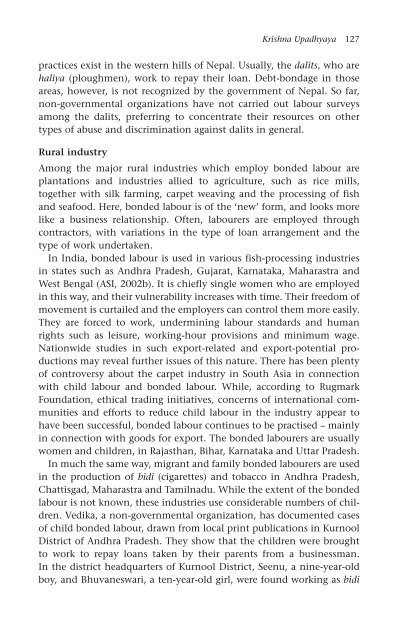3071-The political economy of new slavery
3071-The political economy of new slavery
3071-The political economy of new slavery
Create successful ePaper yourself
Turn your PDF publications into a flip-book with our unique Google optimized e-Paper software.
Krishna Upadhyaya 127<br />
practices exist in the western hills <strong>of</strong> Nepal. Usually, the dalits, who are<br />
haliya (ploughmen), work to repay their loan. Debt-bondage in those<br />
areas, however, is not recognized by the government <strong>of</strong> Nepal. So far,<br />
non-governmental organizations have not carried out labour surveys<br />
among the dalits, preferring to concentrate their resources on other<br />
types <strong>of</strong> abuse and discrimination against dalits in general.<br />
Rural industry<br />
Among the major rural industries which employ bonded labour are<br />
plantations and industries allied to agriculture, such as rice mills,<br />
together with silk farming, carpet weaving and the processing <strong>of</strong> fish<br />
and seafood. Here, bonded labour is <strong>of</strong> the ‘<strong>new</strong>’ form, and looks more<br />
like a business relationship. Often, labourers are employed through<br />
contractors, with variations in the type <strong>of</strong> loan arrangement and the<br />
type <strong>of</strong> work undertaken.<br />
In India, bonded labour is used in various fish-processing industries<br />
in states such as Andhra Pradesh, Gujarat, Karnataka, Maharastra and<br />
West Bengal (ASI, 2002b). It is chiefly single women who are employed<br />
in this way, and their vulnerability increases with time. <strong>The</strong>ir freedom <strong>of</strong><br />
movement is curtailed and the employers can control them more easily.<br />
<strong>The</strong>y are forced to work, undermining labour standards and human<br />
rights such as leisure, working-hour provisions and minimum wage.<br />
Nationwide studies in such export-related and export-potential productions<br />
may reveal further issues <strong>of</strong> this nature. <strong>The</strong>re has been plenty<br />
<strong>of</strong> controversy about the carpet industry in South Asia in connection<br />
with child labour and bonded labour. While, according to Rugmark<br />
Foundation, ethical trading initiatives, concerns <strong>of</strong> international communities<br />
and efforts to reduce child labour in the industry appear to<br />
have been successful, bonded labour continues to be practised – mainly<br />
in connection with goods for export. <strong>The</strong> bonded labourers are usually<br />
women and children, in Rajasthan, Bihar, Karnataka and Uttar Pradesh.<br />
In much the same way, migrant and family bonded labourers are used<br />
in the production <strong>of</strong> bidi (cigarettes) and tobacco in Andhra Pradesh,<br />
Chattisgad, Maharastra and Tamilnadu. While the extent <strong>of</strong> the bonded<br />
labour is not known, these industries use considerable numbers <strong>of</strong> children.<br />
Vedika, a non-governmental organization, has documented cases<br />
<strong>of</strong> child bonded labour, drawn from local print publications in Kurnool<br />
District <strong>of</strong> Andhra Pradesh. <strong>The</strong>y show that the children were brought<br />
to work to repay loans taken by their parents from a businessman.<br />
In the district headquarters <strong>of</strong> Kurnool District, Seenu, a nine-year-old<br />
boy, and Bhuvaneswari, a ten-year-old girl, were found working as bidi


